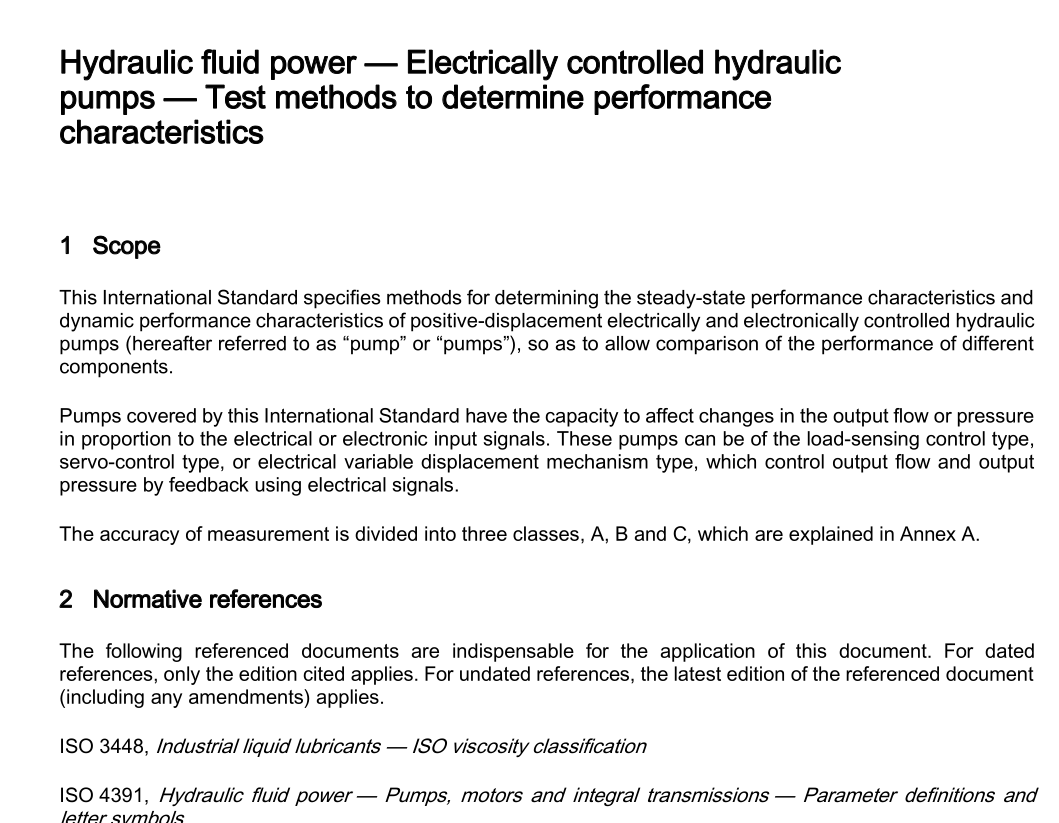BS ISO 17559 pdf download

BS ISO 17559 pdf download Hydraulic fluid power — Electrically controlled hydraulic pumps — Test methods to determine performance characteristics
1 Scope
This International Standard specifies methods for determining the steady-state performance characteristics and dynamic performance characteristics of positive-displacement electrically and electronically controlled hydraulic pumps (hereafter referred to as “pump” or “pumps”), so as to allow comparison of the performance of different components.
Pumps covered by this International Standard have the capacity to affect changes in the output flow or pressure in proportion to the electrical or electronic input signals. These pumps can be of the load-sensing control type,servo-control type, or electrical variable displacement mechanism type, which control output flow and output pressure by feedback using electrical signals.
The accuracy of measurement is divided into three classes, A, B and C, which are explained in Annex A.
2 Normative references
The following referenced documents are indispensable for the application of this document. For dated references, only the edition cited applies. For undated references, the latest edition of the referenced document (including any amendments) applies.
ISO 3448,Industrial liquid lubricants – /SO viscosity classification
SO 4391, Hydraulic fluid power – Pumps,motors and integral transmissions – Parameter definitions andletter symbols
SO 4406,Hydraulic fluid power – Fluids – Method for coding the level of contamination by solid particlesISO 4409,Hydraulic fluid power Positive displacement pumps, motors and integral transmissions -Determination of steady-state performance
ISO 5598,Fluid power systems and components — Vocabulary
3 Terms and definitions
For the purposes of this document, the terms and definitions given in lSO 5598 and the following apply.
3.1
electrically controlled hydraulic pumpvariable displacement pump which is capable of controllina the pressure or flow rate. or the pressure and flowrate corresponding to an input signal
3.2
minimum flow command
minimum input flow command signal needed to maintain the maximum working pressure
3.3
minimum controllable pressureminimum output pressure when the absolute value of the input pressure command signal is zero and the inputflow command signal is maximum (see 7.2.4)
3.4
dead zone
range wherein the output pressure or output flow being controlled by the input signal does not vary when theabsolute value of the input signa increases from zero or decreases to zero
3.5
load volume
gross volume of working fluid in the main pipelines from the outlet of the pump to be tested to the inlet of the
oading valve
3.6
pressure compensation
condition in which the outout flow starts to decrease by the variable displacement control mechanism when theoutput pressure approaches a set pressure
37
deadhead pressure
output pressure without flow
4Symbols
4.1 The physical quantity letter symbols and their suffixes used in this lnternational Standard (see Table 1),are fully explained in ISO 4391
Units are given in Table 1 and Annex A.
4.2Graphical symbols used in Figures 1 and 2. showing test circuit diagrams. conform to ISO 1219-1 anoISO 1219-2.









